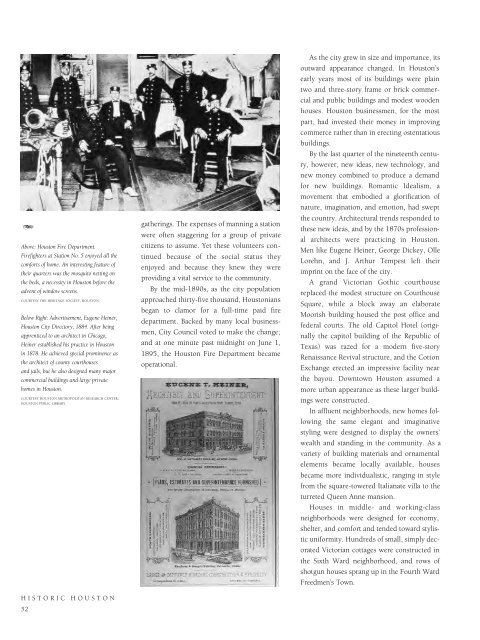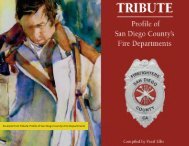Historic Houston
An illustrated history of the City of Houston, Texas, paired with the histories of companies, families and organizations that make the region great.
An illustrated history of the City of Houston, Texas, paired with the histories of companies, families and organizations that make the region great.
Create successful ePaper yourself
Turn your PDF publications into a flip-book with our unique Google optimized e-Paper software.
Above: <strong>Houston</strong> Fire Department.<br />
Firefighters at Station No. 5 enjoyed all the<br />
comforts of home. An interesting feature of<br />
their quarters was the mosquito netting on<br />
the beds, a necessity in <strong>Houston</strong> before the<br />
advent of window screens.<br />
COURTESY THE HERITAGE SOCIETY, HOUSTON.<br />
Below Right: Advertisement, Eugene Heiner,<br />
<strong>Houston</strong> City Directory, 1884. After being<br />
apprenticed to an architect in Chicago,<br />
Heiner established his practice in <strong>Houston</strong><br />
in 1878. He achieved special prominence as<br />
the architect of county courthouses<br />
and jails, but he also designed many major<br />
commercial buildings and large private<br />
homes in <strong>Houston</strong>.<br />
COURTESY HOUSTON METROPOLITAN RESEARCH CENTER,<br />
HOUSTON PUBLIC LIBRARY.<br />
HISTORIC HOUSTON<br />
52<br />
gatherings. The expenses of manning a station<br />
were often staggering for a group of private<br />
citizens to assume. Yet these volunteers continued<br />
because of the social status they<br />
enjoyed and because they knew they were<br />
providing a vital service to the community.<br />
By the mid-1890s, as the city population<br />
approached thirty-five thousand, <strong>Houston</strong>ians<br />
began to clamor for a full-time paid fire<br />
department. Backed by many local businessmen,<br />
City Council voted to make the change;<br />
and at one minute past midnight on June 1,<br />
1895, the <strong>Houston</strong> Fire Department became<br />
operational.<br />
As the city grew in size and importance, its<br />
outward appearance changed. In <strong>Houston</strong>’s<br />
early years most of its buildings were plain<br />
two and three-story frame or brick commercial<br />
and public buildings and modest wooden<br />
houses. <strong>Houston</strong> businessmen, for the most<br />
part, had invested their money in improving<br />
commerce rather than in erecting ostentatious<br />
buildings.<br />
By the last quarter of the nineteenth century,<br />
however, new ideas, new technology, and<br />
new money combined to produce a demand<br />
for new buildings. Romantic Idealism, a<br />
movement that embodied a glorification of<br />
nature, imagination, and emotion, had swept<br />
the country. Architectural trends responded to<br />
these new ideas, and by the 1870s professional<br />
architects were practicing in <strong>Houston</strong>.<br />
Men like Eugene Heiner, George Dickey, Olle<br />
Lorehn, and J. Arthur Tempest left their<br />
imprint on the face of the city.<br />
A grand Victorian Gothic courthouse<br />
replaced the modest structure on Courthouse<br />
Square, while a block away an elaborate<br />
Moorish building housed the post office and<br />
federal courts. The old Capitol Hotel (originally<br />
the capitol building of the Republic of<br />
Texas) was razed for a modern five-story<br />
Renaissance Revival structure, and the Cotton<br />
Exchange erected an impressive facility near<br />
the bayou. Downtown <strong>Houston</strong> assumed a<br />
more urban appearance as these larger buildings<br />
were constructed.<br />
In affluent neighborhoods, new homes following<br />
the same elegant and imaginative<br />
styling were designed to display the owners’<br />
wealth and standing in the community. As a<br />
variety of building materials and ornamental<br />
elements became locally available, houses<br />
became more individualistic, ranging in style<br />
from the square-towered Italianate villa to the<br />
turreted Queen Anne mansion.<br />
Houses in middle- and working-class<br />
neighborhoods were designed for economy,<br />
shelter, and comfort and tended toward stylistic<br />
uniformity. Hundreds of small, simply decorated<br />
Victorian cottages were constructed in<br />
the Sixth Ward neighborhood, and rows of<br />
shotgun houses sprang up in the Fourth Ward<br />
Freedmen’s Town.
















